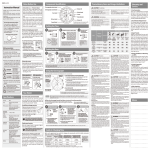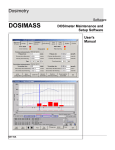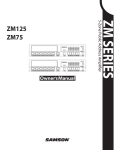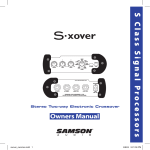Download the Qsnare User Manual in PDF format
Transcript
PERCUSSION MICROPHONES NEODYMIUM DYNAMIC SNARE DRUM MICROPHONE Table Of Contents Introduction and Features 3 Mounting the QSNARE 4 Using The QSNARE 5 QSNARE Characteristics 6 QSNARE Wiring 7 Specifications 7 Copyright 2003, Samson Technologies Corp. Printed February, 2003 Samson Technologies Corp. 575 Underhill Blvd. P.O. Box 9031 Syosset, NY 11791-9031 Phone: 1-800-3-SAMSON (1-800-372-6766) Fax: 516-364-3888 www.samsontech.com 2 Introduction and Features Introduction Congratulations on your purchase of the QSNARE Dynamic Percussion Microphone from Samson Audio! Since we understand that the snare drum is the most important and personal of all the drums in the kit, we carefully designed the QSNARE as a complete solution specifically for snare drum miking applications. Special attention in the construction of the neodymium element, together with precise capsule porting produces a frequency response ideal for snare drum. Capturing the warm low frequencies along with crisps highs, at extremely high sound pressure levels, the QSNARE faithfully reproduces the complex snare sound that will let you cut through the mix, or lay back in the pocket. Extremely sensitive, it employs a tight cardioid pattern to reduce feedback and increase side-to side rejection in close miking situations. In addition to the great sound, the QSNARE features an integral mounting clip that easily installs on any standard drum rim. The multi-adjustable mounting clip allows you to carefully position the mic and completely eliminates the need for external mic stands which can be difficult to position around cymbal stands. Thanks to the great sound and flexible mounting solution, the QSNARE excels in both live performance and recording applications. Should your microphone ever require servicing, a Return Authorization number (RA) must be obtained before shipping your unit to Samson. Without this number, the unit will not be accepted. Please call Samson at 1-800-3SAMSON (1-800-372-6766) for a Return Authorization number prior to shipping your unit. Please retain the original packing materials and if possible return the unit in the original carton and packing materials. Features The Samson QSNARE utilizes state-of-the-art microphone technology and is engineered to the finest detail. Here are some of its main features: • Neodymium, dynamic percussion microphone, designed from bottom to top, specifically for snare drum applications. • Extended frequency range, contoured and optimized for the reproduction of snare drums providing warm low end and crisp high frequency response. • Integral, multi-adjustable mounting clip allows the QSNARE to be easily mounted on any standard drum rim, therefore eliminating the need for an additional mic stand. • Tight cardioid polar pattern minimizes feedback problems and effectively rejects signals from other drums in the kit. • Capable of withstanding high SPLs lending itself to a wide range of close miking applications above and below the snare drum. • Ultra sensitive neodymium element picks up all of the nuances of any performance. • Lightweight and compact, the QSNARE can be mounted on any standard snare drum and easily positioned to stay out of the way of your playing. • Rugged ABS case construction ensures reliable performance in even the most demanding environments. • Included foam-lined, impact resistant carrying case for convenience when transporting the QSNARE microphones from venue to venue. • Gold plated XLR Connector. 3 Mounting the QSNARE Installing the QSNARE to your snare drum with the integral DMC100 mic clip is easy. Follow the simple steps below to install the DMC100 mic clips to your drum kit. • First, get the DMC100 ready for installation. Release the tension on the upper and lower thumbscrews by turning them counter-clockwise. • Next, place the bottom claw the under the bottom edge of the upper drum rim, then push the DMC100 forward until you hear and feel it click into place. • Now, tighten the lower thumbscrew to secure the DMC100 firmly to the rim. • Adjust the height and tighten the upper thumbscrew in place. • Once the DMC100 clip is fixed in place and the height is set, you can adjust the angle. Note: While adjusting the angle, you will want to place the mic in a position that is least likely to interfere with your playing style. Because of the QSNARE’s pick-up pattern, and due to a phenomenon called proximity effect, slight adjustments of the microphone position and angle can make a big difference in sound. For further information on positioning your microphone see the section “Microphone Placement and Tone Quality” on page 5 of this manual. • Connect the QSNARE using a standard XLR mic cable and dress the wire away from your drum using the cable strain relief. Note: For more information on wiring and mic cables, see page 7 in this manual. 4 Using the QSNARE Microphone Placement and Tone Quality When you mount the QSNARE to your drum, it will be easy to get a great sound since the mic is positioned so close to the sound source. You can make slight adjustments to the height and angle that will have an effect on the sound. The changes in sound may be difficult to notice at first, especially in live sound applications, however the more you use your microphone and listen to the sound, the more you will understand, and hear, the effect the microphone placement has on the sound. As always, experimentation and experience are the best teachers. Obviously, in live sound applications you can’t always hear the final results of the sound you’re getting because most of the time your drum kit will be positioned behind the PA speakers, so rely on a band mate or sound engineer to help you dial up the sound. In recording applications, print some scratch tracks and check the sound by listening back in your headphones and in the control room monitors. By the way, the “Golden Rule” of getting a great sound miking any instrument, with any microphone, is to start with a great sounding instrument. Be sure that you pay careful attention to the tuning, and if necessary, the dampening of your drum. Miking your drum is similar to putting the sound under a microscope. Any unwanted buzzes and rattles coming from your instrument may be much more noticeable when you mic the drum. You’ll get a great sound just by mounting the QSNARE to your drum however, there are some basic principles and fundamentals that should be followed. (If not, at least understood.) • The QSNARE has a cardioid pick up pattern, which means it picks up sound directly in front of the microphone, and rejects the sound directly behind the microphone. This means in order to get the best separation between the sound you want to pick up in the mic (for example your snare), and the ambient sound around it, let’s say your Hi-Hat, you can aim the mic so that it is facing away from the Hi-Hat. As with any drum miking situation, you’ll have to make some compromises with the ultimate position for sound and interface in your playing style. For more information on polar patterns, see the section Polar Pattern on page 6 of this manual. • All microphones, especially uni-directional or cardioid microphones, exhibit a phenomenon known as “proximity effect.” Very simply put, proximity effect is a resulting change in the frequency response of a microphone based on the position of the mic capsule relative to the sound source. Due to the result of the proximity effect, slight adjustments of the microphone position and angle can make a big difference in sound. Specifically, when you point a cardioid mic directly at the sound source (on axis) you will get the best frequency response, however when you start pointing the microphone slightly away (off axis) you will notice the low frequency response dropping off and the microphone will start to sound thinner. Knowing that the bass will decrease as you change the mic angle can be a big help if you are getting a “boomy” sound from your drum. 5 QSNARE Characteristics Every microphone has a characteristic polar pattern that determines how well it accepts or rejects signal coming from various areas around the microphone. For example, omnidirectional mics accept all signals regardless of wherever those signals originate (in front of the mic, behind it, to the side, etc.). In contrast, directional cardioid mics are specifically designed to accept mostly signal coming from directly in front, and to reject signal coming from behind or from the side. The cardioid pattern is utilized by the QSNARE (as shown in the illustration below). For this reason, the QSNARE excels in environments where there is a good deal of unwanted ambient sound—it delivers those signals originating directly in front of the mic capsule itself while rejecting those that originate from behind. The polar pattern also determines how prone a particular mic is to inducing feedback. Feedback is that characteristic nasty howling sound that occurs when a mic is placed too close to a loudspeaker—the signal from the loudspeaker is fed into the mic, then into the loudspeaker, then into the mic, over and over again until an oscillating tone is generated. Because the cardioid pattern utilized by the QSNARE is so good at rejecting signal not coming from directly in front of the mic, you’ll find that use of the QSNARE greatly minimizes feedback problems. QSNARE Polar Pattern QSNARE Frequency Chart 6 QSNARE Specifications The QSNARE can be connected to any mixer, mixer/amplifier, or mic preamp using a standard microphone cable. As shown in the wiring diagrams below, connect the female XLR end directly to the QSNARE’s gold-plated connector and the other end (normally a male XLR end, although some mixers use 1/4" connectors) to the mixer, mixer/amplifier, or mic preamp. QSNARE Specifications Type Dynamic Microphone Polar Pattern Super Cardioid Frequency Response 50~16000 Hz Sensitivity -55 dBV/pa (0.78mv/pa) Raded Impedance 200Ω Max. SPL 133 dB (THD≤ 0.5% 1000 Hz) Weight 150g (with DMC 100) 7 Samson Technologies Corp. 575 Underhill Blvd. P.O. Box 9031 Syosset, NY 11791-9031 Phone: 1-800-3-SAMSON (1-800-372-6766) Fax: 516-364-3888 www.samsontech.com
























